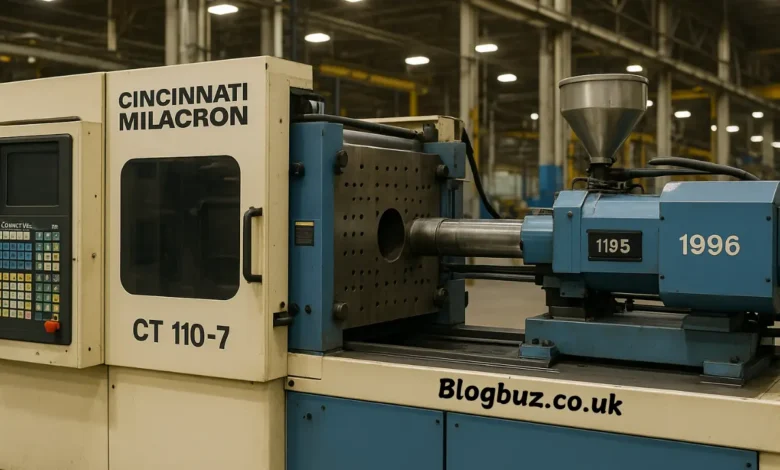CT 110-7 Cincinnati Milacron 1996: The Workhorse of Injection Molding Machines

In the realm of plastic manufacturing, precision, productivity, and dependability are crucial characteristics that significantly impact overall performance. One machine that has stood the test of time in this regard is the CT 110-7 Cincinnati Milacron 1996 injection molding machine. A favorite among manufacturers, this powerful piece of equipment represents an era when robust engineering met advanced hydraulic technology. This article offers an in-depth look into the specifications, advantages, applications, and legacy of the CT 110-7 Cincinnati Milacron from 1996.
Introduction to Cincinnati Milacron
Cincinnati Milacron, originally known as the Cincinnati Milling Machine Company, has been a pillar in the industrial manufacturing sector since the 19th century. Known for producing high-quality milling machines, the company diversified into plastic injection molding machinery in the mid-20th century. The CT 110-7 is one such model that reflects Milacron’s commitment to durability, precision, and operational excellence.
Overview of the CT 110-7 Model
The CT 110-7, also labeled in some listings as VT 110-7, is a hydraulic injection molding machine with a clamping force of 110 tons. Manufactured in 1996, this machine has found widespread use in medium-sized plastic production facilities due to its balance of power and footprint.
Key Specifications
| Feature | Specification |
|---|---|
| Clamping Force | 110 tons (approx. 998 kN) |
| Shot Size | 7–10 ounces (≈200–285 g) |
| Year of Manufacture | 1996 |
| Control System | CAMAC V5x |
| Hydraulic System | Variable-displacement pumps |
| Power Supply | 460V, 3-phase |
| Platen Size | ~24.8″ × 22.8″ |
| Tie Bar Spacing | ~16.1″ × 14.2″ |
| Clamp Stroke | ~11.8″ |
| Daylight Opening | ~27.6″ |
| Machine Weight | Approx. 13,100 lbs |
Advanced CAMAC V5x Control System
The CAMAC V5x is a microprocessor-based control system designed to allow precise and repeatable operations. It was ahead of its time in 1996, offering:
- Memory for multiple mold setups
- Adjustable parameters for pressure, speed, and temperature
- Real-time diagnostics and alarms
This control system enhanced operational efficiency and significantly reduced downtime, which made the CT 110-7 an appealing choice for manufacturers.
Hydraulic Efficiency and Performance
Unlike older machines with fixed displacement pumps, the CT 110-7 utilized variable-displacement hydraulics, which allowed it to:
- Adjust hydraulic flow as needed
- Reduce energy consumption
- Lower operational heat, minimizing wear and tear
This efficiency resulted in reduced operational costs and an extended service life.
Build Quality and Durability
One of the reasons the CT 110-7 is still in operation in many facilities is its rugged construction. Manufactured during a time when industrial machines were over-engineered for longevity, this model features:
- Heavy-duty cast components
- High-tensile steel tie bars
- Reinforced platens
- Easy maintenance accessibility
These features ensure a long operational life, even under continuous use.
Applications of CT 110-7 Injection Molding Machine
Thanks to its versatile design and efficient performance, the CT 110-7 Cincinnati Milacron 1996 is used across various industries:
- Automotive: Small connectors, interior clips, dashboard components
- Medical Devices: Syringes, diagnostic casings, tubing connectors
- Consumer Goods: Plastic handles, containers, packaging caps
- Electronics: Cable management parts, sensor housings
The machine is capable of processing a diverse array of thermoplastics, including ABS, PP, PE, and Nylon.
Market Value and Availability
Even after nearly three decades, the CT 110-7 remains a valuable asset in the secondary machinery market. It is commonly listed on industrial auction platforms like:
- AllSurplus
- MachinesUsed.com
- GovDeals
- PlasticsOne
Depending on its condition and usage hours, it is priced between $7,000 and $20,000.
Maintenance and Parts Availability
Due to its long-standing presence in the industry, spare parts for the CT 110-7 are relatively easy to obtain. Several third-party suppliers and refurbishing companies specialize in:
- Hydraulic seal kits
- Control panel components
- Clamping unit upgrades
- Servo motor retrofits
Routine maintenance includes hydraulic fluid checks, nozzle cleaning, and periodic inspection of the tie bars and platens.
Environmental and Safety Compliance
While the CT 110-7 was built before modern energy-efficiency standards, its variable-displacement hydraulic system gives it a surprising edge in power management. For safety, retrofitted machines often include:
- Updated emergency stop systems
- Light curtain barriers
- Lockout/tagout compatibility
This makes the CT 110-7 compliant with many modern factory standards after basic retrofitting.
Why the CT 110-7 Remains Relevant
In an era of all-electric and hybrid injection molding machines, a 1996 model is outdated. However, many shops still use the CT 110-7 due to:
- Its low cost of ownership
- Ease of use and maintenance
- Availability of trained technicians
- Reliable part quality over long runs
These advantages make it a go-to machine for small to mid-sized production runs, especially in developing markets.
Comparing CT 110-7 with Modern Alternatives
| Feature | CT 110-7 (1996) | Modern Electric Machines |
| Control | CAMAC V5x | PLC/HMI with touchscreen |
| Efficiency | Moderate | High (Energy-saving) |
| Maintenance | Mechanical/hydraulic | Software-intensive |
| Cost | Low | High |
| Learning Curve | Easy | Moderate to High |
Conclusion
The CT 110-7 Cincinnati Milacron 1996 is more than just a piece of vintage machinery. It is a testament to robust American engineering and industrial design. Its powerful performance, durable components, and cost-effective operation continue to make it a trusted companion in the injection molding industry.
You May Also Read: 70537865 Allis: An Essential Industrial Component for Heavy Machinery




